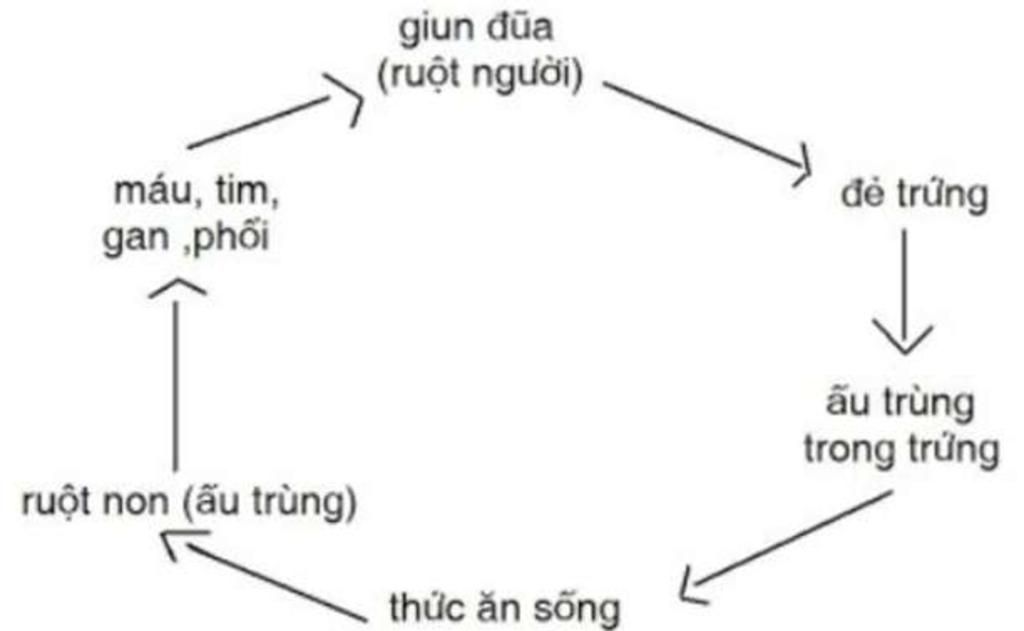1.Cấu tạo, di chuyển, sinh sản của động vật nguyên sinh 2.Đặc điểm chung và vai trò của ngành ruột khoang 3.Sơ đồ vòng đời của sáng lá gan, giun đũa 4.Tác hại và phòng chống bệnh giun sán 5. Giair thích 1 số hiện tượng về giun đất
2 câu trả lời
Bài 1 :
- Kích thước hiển vi
- Cấu tạo từ một tế bào
- Phần lớn là dị dưỡng
- Di chuyển bằng roi, lông bơi và chân giả
- Phần lớn sinh sản vô tính bằng cách phân đôi.
Bài 2 : Đặc điểm chung :
- Cơ thể đối xứng tỏa tròn
- Ruột dạng túi
- Thành cơ thể cấu tạo gồm hai lớp
- Tế bào gai là tế bào để tự vệ và tấn công .
Vai trò :
- Tạo vẻ đẹp thiên nhiên
-Có ý nghĩa sinh thái đối với biển
- Làm đồ trang sức và trang trí : San hô
- Cung cấp nguyên liệu vôi cho xây dựng : San hô
- Làm vật chỉ thị cho tầng địa chất : hóa thạch san hô
- làm thực phẩm có giá trị : Sứa
Bài 3 : Sán lá gan :
(Gan trâu,bò) => (Trứng ở trong phân) =gặp nước=> ấu trùng lông => kí sinh trong ốc => ấu trùng có đuôi => kén sán bám vào rau =trâu bò ăn=>kí sinh trong gan ( vòng lặp lại từ đầu )
Giun đũa :
Trứng => ấu trùng trong trứng =qua thức ăn=> ruột non =chui ra=> đi vào máu, gan, tim, phổi=> về lại ruột non ( vòng lặp lại từ đầu )
Bài 4 : tác hại :
- gây xanh xao, nhợt nhạt
- thiếu chất dinh dưỡng
- gây tắc ông mật, tất ruộc
- gây đau bụng
Biện pháp :
- không mút, cắn móng tay
- rửa rau sạch
- rửa tay trước khi ăn
- tẩy giun 1-2 lần trong 1 năm
- không ăn thịt trâu, bò, lợn gạo
- không uống nước bẩn
-không đi chân trần ở ngoài đất
- Vệ sinh môi trường
- Vệ sinh cá nhân
- chế biến rau xanh
- xử lí phân
Bài 5 :
- Khi cuốc phải giun đất có chất lỏng chảy ra đó chính là máu của giun đất
--------------------------Hết-------------------------
Nếu bạn thấy hay thì vote cho mình hay nhất nhé, cảm ơn ^^
1. - Cấu tạo: từ một tế bào đảm nhận mọi hoạt động sống
- Sinh sản: vô tính bằng hình thức phân đôi
- Dinh dưỡng: kiểu dị dưỡng và tự dưỡng.
- Di chuyển: bằng roi,lông bơi,chân giả hoặc không có
2. - Đặc điểm cung:
+ Cơ thể đối xứng tỏa tròn.
+ Sống dị dưỡng.
+ Thành cơ thể gồm 2 lớp tế bào, giữa là tầng keo.khoang cơ thể rỗng (chưa phân hóa)
+ Ruột dạng túi. (gọi là ruột khoang)
+ Tấn công và tự vệ bằng tế bào gai.
- Vai trò:
* Lợi ích trong tự nhiên
- Ngành ruột khoang có ý nghĩa sinh thái đối với biển và đại dương, cung cấp thức ăn và nơi ẩn nấp cho một số động vật.
- Ngành ruột khoang tạo ra một cảnh quan thiên nhiên vô cùng độc đáo và là điều kiện để phát triển du lịch như đảo san hô vùng nhiệt đới.
* Lợi ích đối với đời sống
- Ngành ruột khoang là nguyên liệu dùng để làm đồ trang sức, trang trí như vòng tay, vòng cổ… làm bằng san hô.
- Làm vật liệu xây dựng: san hô đá
- Là vật chỉ thị cho tầng địa chất: hóa thạch san hô
- Làm thực phẩm: gỏi sứa
* Tác hại của ngành ruột khoang
- Một số loài sứa có thể gây ngứa và độc: sứa lửa
- Cản trở giao thông đường biển: đảo san hô ngầm
3.
4.
*Tác hại:
-Lấy chất dinh dưỡng, thức ăn của vật chủ
-Gây viêm nhiễm nơi kí sinh
-Gây tắc ruột, tắc ống mật
-Thải các chất độc tố gây hại
-> Vật chủ ko phát triển đc
*Biện pháp:
-Rửa tay trước khi ăn và sau khi đi vệ sinh
-Rửa các loại rau,củ,quả thật kĩ bằng nước muối trước khi ăn
-Uống thuốc tẩy giun theo định kì
-Ăn chín uống sôi
5. - Giun hô hấp qua da, khi mưa nhiều nước ngập lỗ và làm cho đất chặt => thiếu oxi nên giun phải bò lên mặt đất để lấy oxi.
- Chất lỏng màu đỏ là máu của giun. Máu của giun có màu đỏ vì trong máu có huyết sắc tố, có thành phần hemoglobin trong đó có nhân sắt làm máu có màu đỏ.



